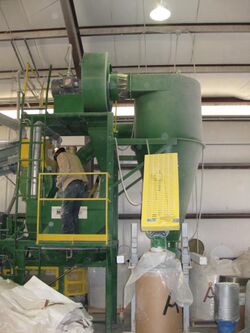Biology:KDS Micronex
The KDS Micronex is a patented grinder-dryer which grinds and dries materials in a single-step process without needing any heat input. It is manufactured and sold by First American Scientific Corp. of Abbotsford, British Columbia.
The KDS (Kinetic Disintegration System) was originally developed by Spectrasonic Disintegration Equipment Corp. and was licensed to First American Scientific Corp. from 1995 until 1999. [1] First American Scientific Corp. purchased ownership of the KDS technology in 1999 and has since been awarded three American patents protecting its applications. The North American patents protecting the KDS technology are:
Device and method for comminution - US Patent # 6,024,307 and Canadian Patent # 2,218,429
Cryogenic comminution of rubber - US Patent # 6,655,167
Method of recovery of precious metal & heavy minerals - US Patent # 6,682,005
Recovery of fuel and clay from a biomass - US Patent # 7,481,385
Grinding and drying characteristics
The KDS Micronex grinds materials that are fed onto spinning chains or bars located in a grinding chamber. Tip speeds of 200 m/s create high velocity airflows (4000 cfm)[2] and produce high velocity impacts when striking the materials being processed. A simultaneous drying event occurs because:
-the repeated striking of the materials against the chains, baffle plates contained inside the grinding chamber, and against themselves create kinetic energy which heats the material
-the high velocity impacts force moisture out of the material, and reduce particle size (increasing exposure to evaporating airflow)
-the airflows created help to evaporate surface moisture and its airflows keep the particles suspended in air (allowing for air to flow over the complete surface area of the material)
Once the materials reach a pre-determined size they will pass through an internal classifier. The classifier in the unit controls the particle size within the range between 30-325 Mesh (scale).[3]
Government-funded research and development
The KDS Micronex has been the subject of funding from municipal, state and federal levels of government, with funding coming from:
United States Department of Energy to determine the optimum design parameters for the machine and predict its performance[4][5]
Sustainable Development Technology Canada to demonstrate the ability of the KDS to de-water waste from the pulp and paper industry for use as hog fuel as well as its ability to recycle its components[6][7]
United States Department of Agriculture to research "Integrated Size Reduction and Separation to Pre-Fractionate Biomass"[8][9]
Waste & Resources Action Programme (UK) to derive economic opportunities from paper mill sludge through its recycling into usable materials[10]
City of Prince George, B.C. to test the ability of the KDS Micronex to depathogenize biosolids for its use as a class “A” fertilizer[11]
Minnesota Department of Agriculture NextGen Energy Board (in addition to funding from Xcel Energy, Inc.) to research the ability of the KDS Micronex to dry various biomass feedstocks for pellet fuel production.[12][13]
References
- ↑ "First American Scientific Corp. annual report". Securities & Exchange Commission filing. June 30, 2000. https://www.sec.gov/Archives/edgar/data/1002822/000100201400000146/0001002014-00-000146.txt.
- ↑ "Pilot Testing of the Micronex™ System to Produce a Class A Biosolids". Dayton & Knight Ltd., John W.C. Boyle P. Eng.. 2007. https://www.bcwwa.org/resourcelibrary/Boyle,%20John%20-%20Pilot%20Testing%20of%20the%20Micronex%20System.pdf.[yes|permanent dead link|dead link}}]
- ↑ "Biomass Products & Technology". February 2010. http://www.gobiomass.com/article.cfm?id=27717.
- ↑ "Small Business Technology Transfer (STTR) project: Combined Drying and Grinding of Biomass in One Operation". United States Department of Energy. 2003. http://www.sbir.gov/sbirsearch/detail/267300.
- ↑ "Small Business Technology Transfer (STTR) project: Combined Drying and Grinding of Biomass in One Operation". United States Department of Energy. 2008. http://www.osti.gov/bridge/servlets/purl/939887/939887.pdf.
- ↑ "Alternative Green Energy Systems Inc. - Thermix/KDS Biomass Combustion System". Sustainable Development Technology Fund - 2008 Annual Report Supplement. http://www.sdtc.ca/uploads/documents/en/2008_AR_Supplement.pdf.
- ↑ "Recovery and utilization of fibre from recycled papermill sludge". Centre for Biocomposites and Biomaterials Processing, Faculty of Forestry, University of Toronto, Canada. 2005. http://cat.inist.fr/?aModele=afficheN&cpsidt=17078790.
- ↑ "Integrated Size Reduction and Separation to Pre-Fractionate Biomass". Annual Report to Congress on the Biomass Research and Development Initiative for FY 2004. Submitted Jointly by The U.S. Department of Agriculture & The U.S. Department of Energy. 2005. http://www.usbiomassboard.gov/pdfs/biomass_initiative_report_to_congress_fy04_submitted.pdf.
- ↑ "Integrated Size Reduction and Separation to Pre-Fractionate Biomass". University of Tennessee, Al Womac, Ph.D, P.E.. 2005. http://feedstockreview.ornl.gov/pdf/womac/session3_womac.pdf.
- ↑ "A New Approach to Paper Mill Sludge". Waste & Resources Action Programme. 2007. http://www2.wrap.org.uk/downloads/MSP002_Final_Report_April_2007.3e4caae3.3674.pdf.[|permanent dead link|dead link}}]
- ↑ "Pilot Testing of the Micronex™ System to Produce a Class A Biosolids". Dayton & Knight Ltd., John W.C. Boyle P. Eng.. 2007. https://www.bvsde.paho.org/bvsaar/cdlodos/pdf/pilottesting335.pdf.
- ↑ "Application of Kinetic Disintegration System to Process Biomass Feedstocks for Pelletization". Xcel Energy Renewable Development Fund. http://www.xcelenergy.com/Environment/Renewable_Energy/Renewable_Energy_Grants/RDF_Active_Biomass_Projects.
- ↑ "Focusing on Feed and Fuel". Biomass Magazine. May 2011. http://biomassmagazine.com/articles/5540/focusing-on-feed-and-fuel.


